brake light TOYOTA TACOMA 2016 Owners Manual (in English)
[x] Cancel search | Manufacturer: TOYOTA, Model Year: 2016, Model line: TACOMA, Model: TOYOTA TACOMA 2016Pages: 640, PDF Size: 40.18 MB
Page 3 of 640
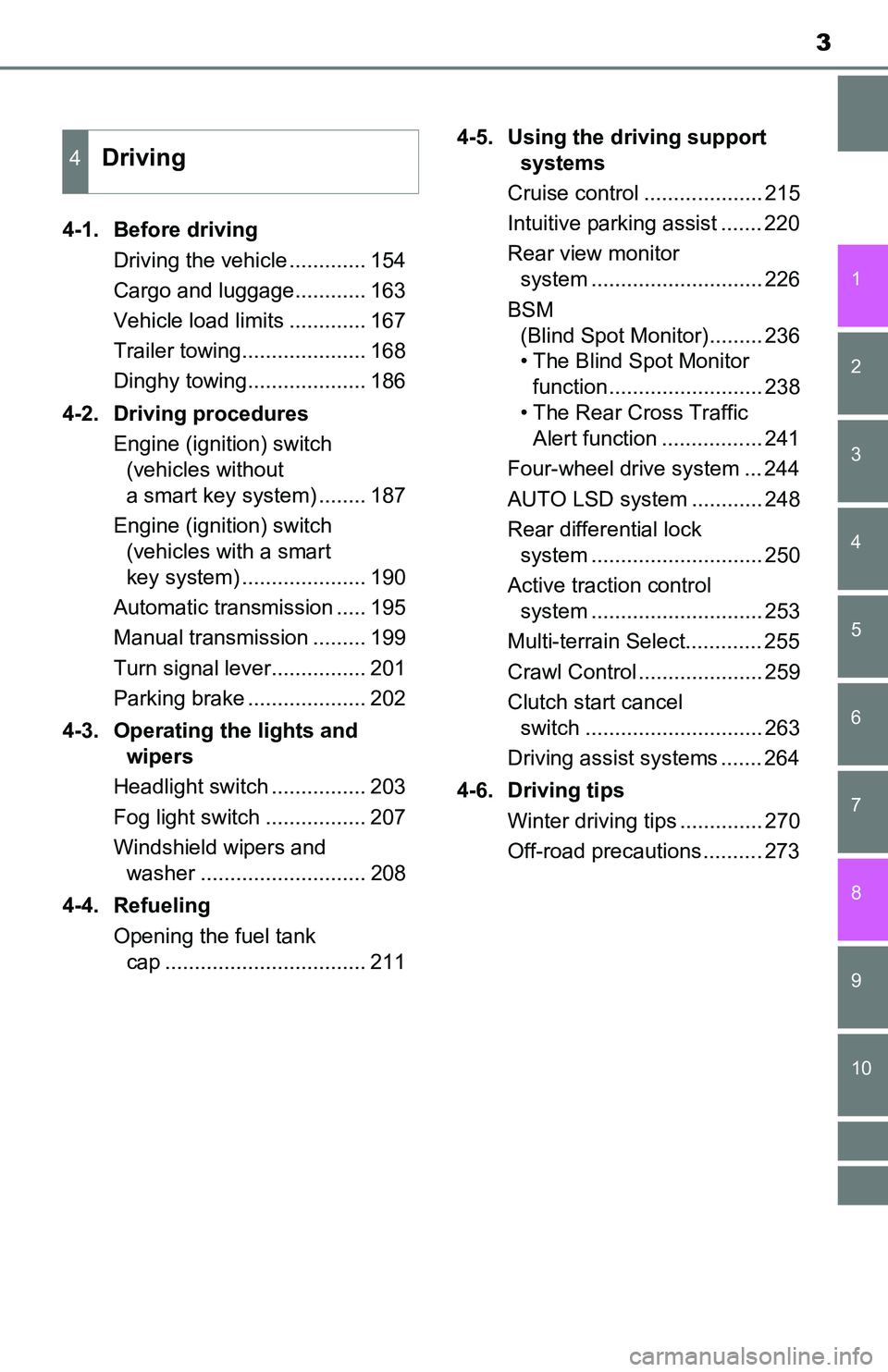
3
1
9 8
7 5 4
3
2
10
6
4-1. Before driving
Driving the vehicle ............. 154
Cargo and luggage............ 163
Vehicle load limits ............. 167
Trailer towing..................... 168
Dinghy towing.................... 186
4-2. Driving procedures
Engine (ignition) switch
(vehicles without
a smart key system) ........ 187
Engine (ignition) switch
(vehicles with a smart
key system) ..................... 190
Automatic transmission ..... 195
Manual transmission ......... 199
Turn signal lever................ 201
Parking brake .................... 202
4-3. Operating the lights and
wipers
Headlight switch ................ 203
Fog light switch ................. 207
Windshield wipers and
washer ............................ 208
4-4. Refueling
Opening the fuel tank
cap .................................. 2114-5. Using the driving support
systems
Cruise control .................... 215
Intuitive parking assist ....... 220
Rear view monitor
system ............................. 226
BSM
(Blind Spot Monitor)......... 236
• The Blind Spot Monitor
function.......................... 238
• The Rear Cross Traffic
Alert function ................. 241
Four-wheel drive system ... 244
AUTO LSD system ............ 248
Rear differential lock
system ............................. 250
Active traction control
system ............................. 253
Multi-terrain Select............. 255
Crawl Control ..................... 259
Clutch start cancel
switch .............................. 263
Driving assist systems ....... 264
4-6. Driving tips
Winter driving tips .............. 270
Off-road precautions .......... 273
4Driving
Page 17 of 640
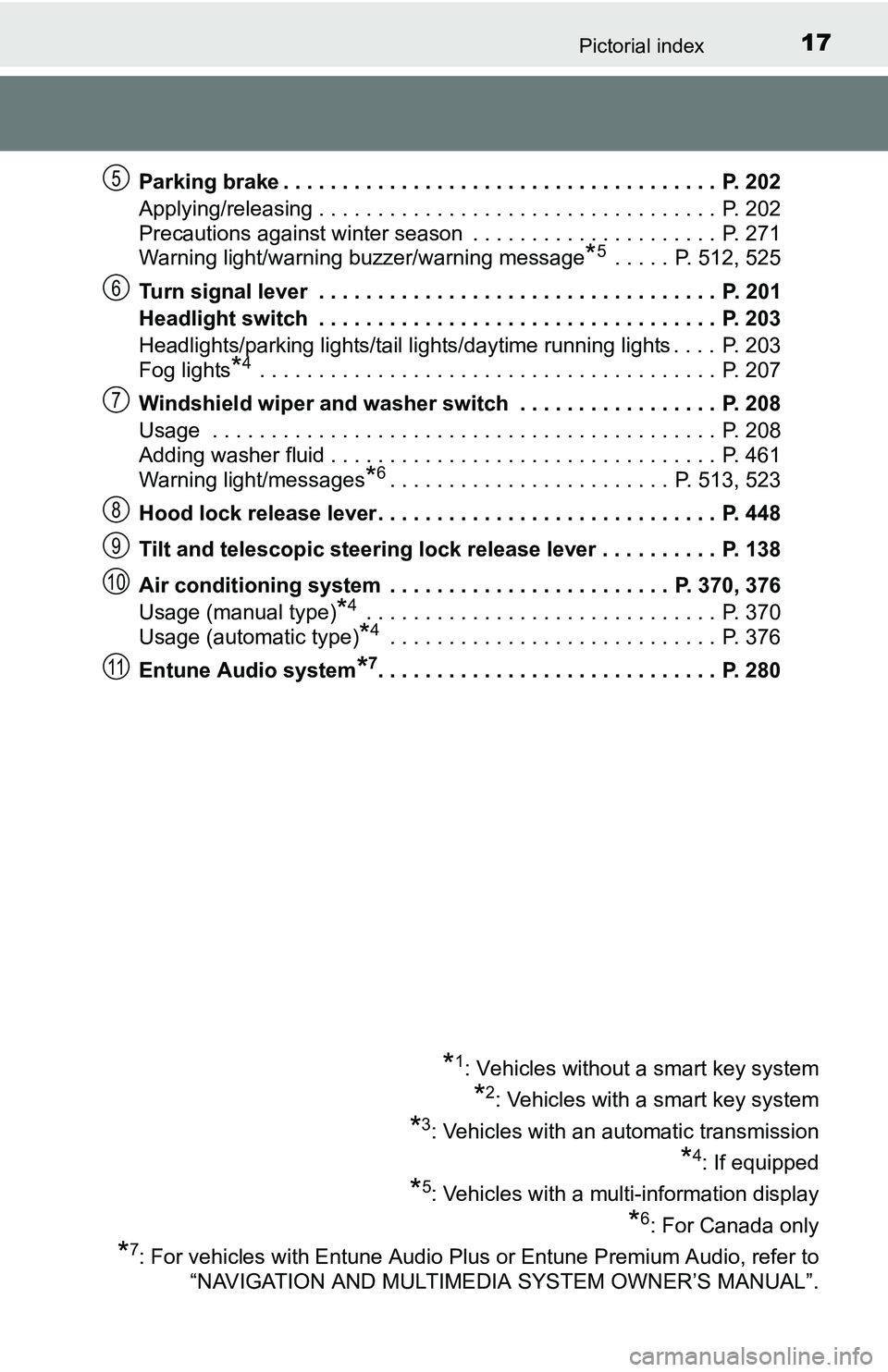
17Pictorial index
Parking brake . . . . . . . . . . . . . . . . . . . . . . . . . . . . . . . . . . . . . P. 202
Applying/releasing . . . . . . . . . . . . . . . . . . . . . . . . . . . . . . . . . . P. 202
Precautions against winter season . . . . . . . . . . . . . . . . . . . . . P. 271
Warning light/warning buzzer/warning message
*5 . . . . . P. 512, 525
Turn signal lever . . . . . . . . . . . . . . . . . . . . . . . . . . . . . . . . . . P. 201
Headlight switch . . . . . . . . . . . . . . . . . . . . . . . . . . . . . . . . . . P. 203
Headlights/parking lights/tail lights/daytime running lights . . . . P. 203
Fog lights
*4 . . . . . . . . . . . . . . . . . . . . . . . . . . . . . . . . . . . . . . . P. 207
Windshield wiper and washer switch . . . . . . . . . . . . . . . . . P. 208
Usage . . . . . . . . . . . . . . . . . . . . . . . . . . . . . . . . . . . . . . . . . . . P. 208
Adding washer fluid . . . . . . . . . . . . . . . . . . . . . . . . . . . . . . . . . P. 461
Warning light/messages
*6. . . . . . . . . . . . . . . . . . . . . . . . P. 513, 523
Hood lock release lever. . . . . . . . . . . . . . . . . . . . . . . . . . . . . P. 448
Tilt and telescopic steering lock release lever . . . . . . . . . . P. 138
Air conditioning system . . . . . . . . . . . . . . . . . . . . . . . . P. 370, 376
Usage (manual type)
*4 . . . . . . . . . . . . . . . . . . . . . . . . . . . . . . P. 370
Usage (automatic type)
*4 . . . . . . . . . . . . . . . . . . . . . . . . . . . . P. 376
Entune Audio system
*7. . . . . . . . . . . . . . . . . . . . . . . . . . . . . P. 280
*1: Vehicles without a smart key system
*2: Vehicles with a smart key system
*3: Vehicles with an automatic transmission
*4: If equipped
*5: Vehicles with a multi-information display
*6: For Canada only
*7: For vehicles with Entune Audio Plus or Entune Premium Audio, refer to
“NAVIGATION AND MULTIMEDIA SYSTEM OWNER’S MANUAL”.
5
6
7
8
9
10
11
Page 83 of 640
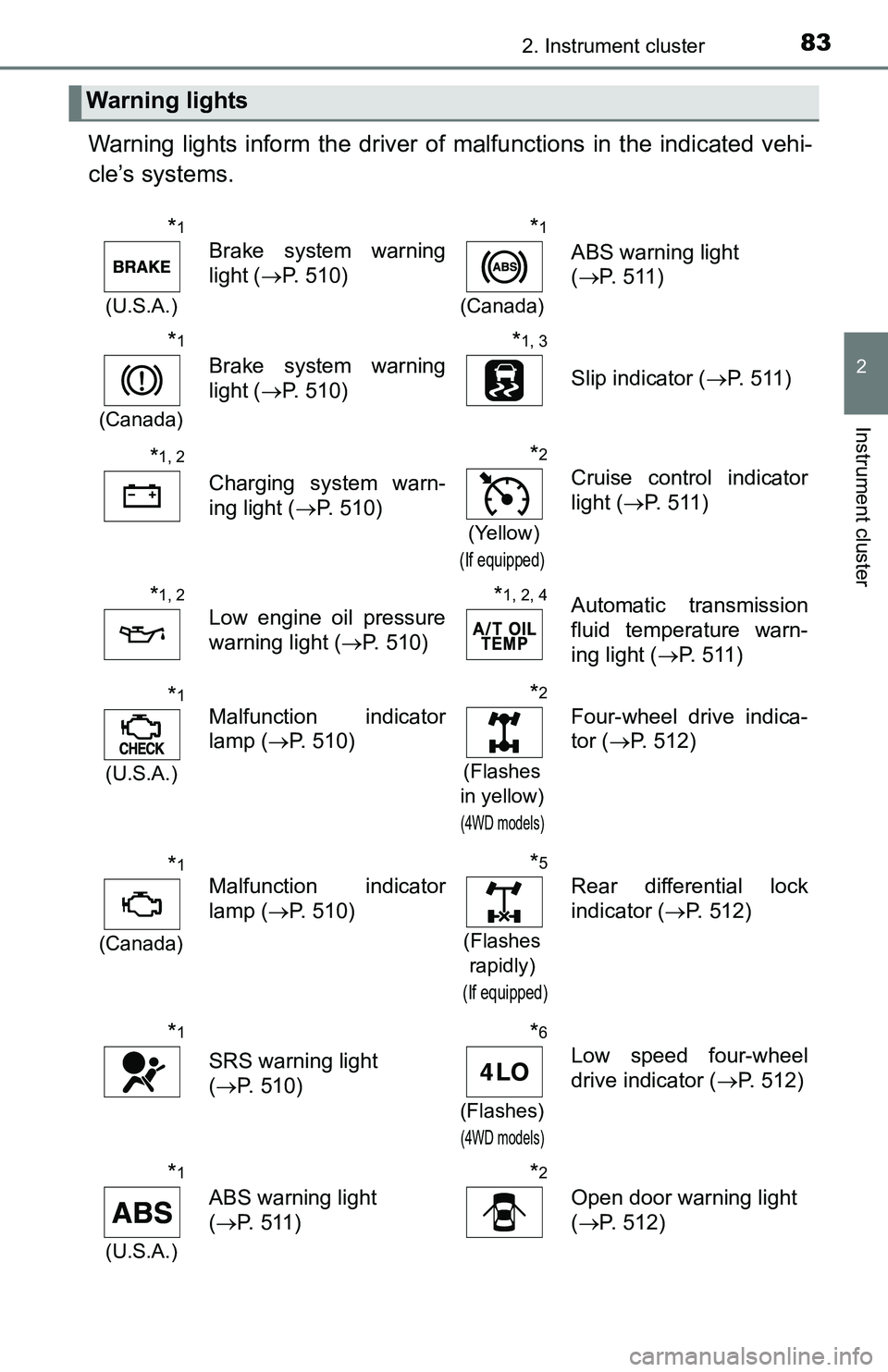
832. Instrument cluster
2
Instrument cluster
Warning lights inform the driver of malfunctions in the indicated vehi-
cle’s systems.
Warning lights
*1
(U.S.A.)
Brake system warning
light (P. 510)
*1
(Canada)
ABS warning light
(P. 511)
*1
(Canada)
Brake system warning
light (P. 510)
*1, 3
Slip indicator (P. 511)
*1, 2
Charging system warn-
ing light (P. 510)
*2
(Yellow)
(If equipped)
Cruise control indicator
light (P. 511)
*1, 2
Low engine oil pressure
warning light (P. 510)*1, 2, 4Automatic transmission
fluid temperature warn-
ing light (P. 511)
*1
(U.S.A.)
Malfunction indicator
lamp (P. 510)
*2
(Flashes
in yellow)
(4WD models)
Four-wheel drive indica-
tor (P. 512)
*1
(Canada)
Malfunction indicator
lamp (P. 510)
*5
(Flashes
rapidly)
(If equipped)
Rear differential lock
indicator (P. 512)
*1
SRS warning light
(P. 510)
*6
(Flashes)
(4WD models)
Low speed four-wheel
drive indicator (P. 512)
*1
(U.S.A.)
ABS warning light
(P. 511)
*2
Open door warning light
(P. 512)
Page 84 of 640
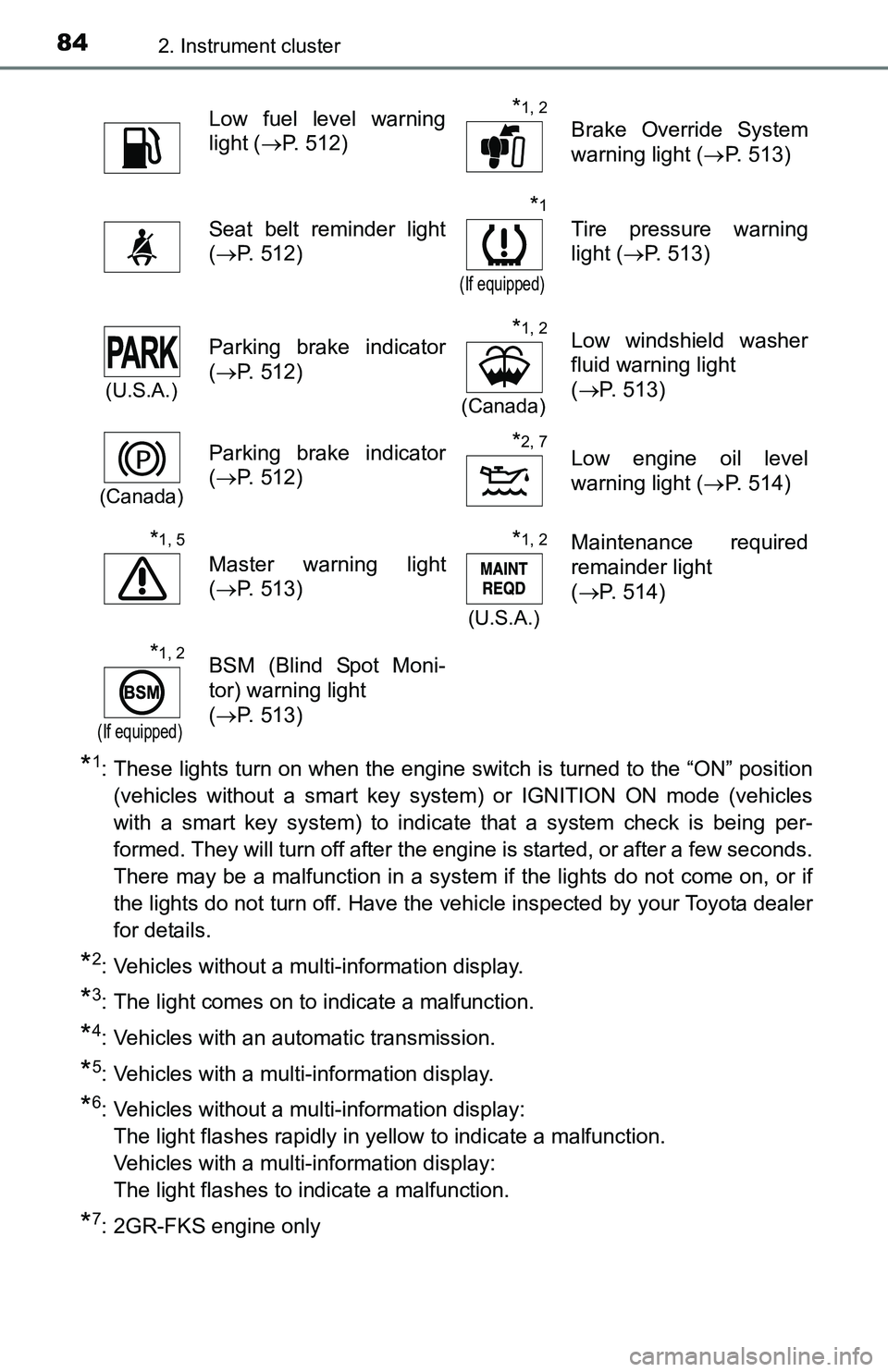
842. Instrument cluster
*1: These lights turn on when the engine switch is turned to the “ON” position
(vehicles without a smart key system) or IGNITION ON mode (vehicles
with a smart key system) to indicate that a system check is being per-
formed. They will turn off after the engine is started, or after a few seconds.
There may be a malfunction in a system if the lights do not come on, or if
the lights do not turn off. Have the vehicle inspected by your Toyota dealer
for details.
*2: Vehicles without a multi-information display.
*3: The light comes on to indicate a malfunction.
*4: Vehicles with an automatic transmission.
*5: Vehicles with a multi-information display.
*6: Vehicles without a multi-information display:
The light flashes rapidly in yellow to indicate a malfunction.
Vehicles with a multi-information display:
The light flashes to indicate a malfunction.
*7: 2GR-FKS engine only
Low fuel level warning
light (P. 512)*1, 2
Brake Override System
warning light (P. 513)
Seat belt reminder light
(P. 512)
*1
(If equipped)
Tire pressure warning
light (P. 513)
(U.S.A.)
Parking brake indicator
(P. 512)*1, 2
(Canada)
Low windshield washer
fluid warning light
(P. 513)
(Canada)
Parking brake indicator
(P. 512)*2, 7Low engine oil level
warning light (P. 514)
*1, 5
Master warning light
(P. 513)
*1, 2
(U.S.A.)
Maintenance required
remainder light
(P. 514)
*1, 2
(If equipped)
BSM (Blind Spot Moni-
tor) warning light
(P. 513)
Page 86 of 640
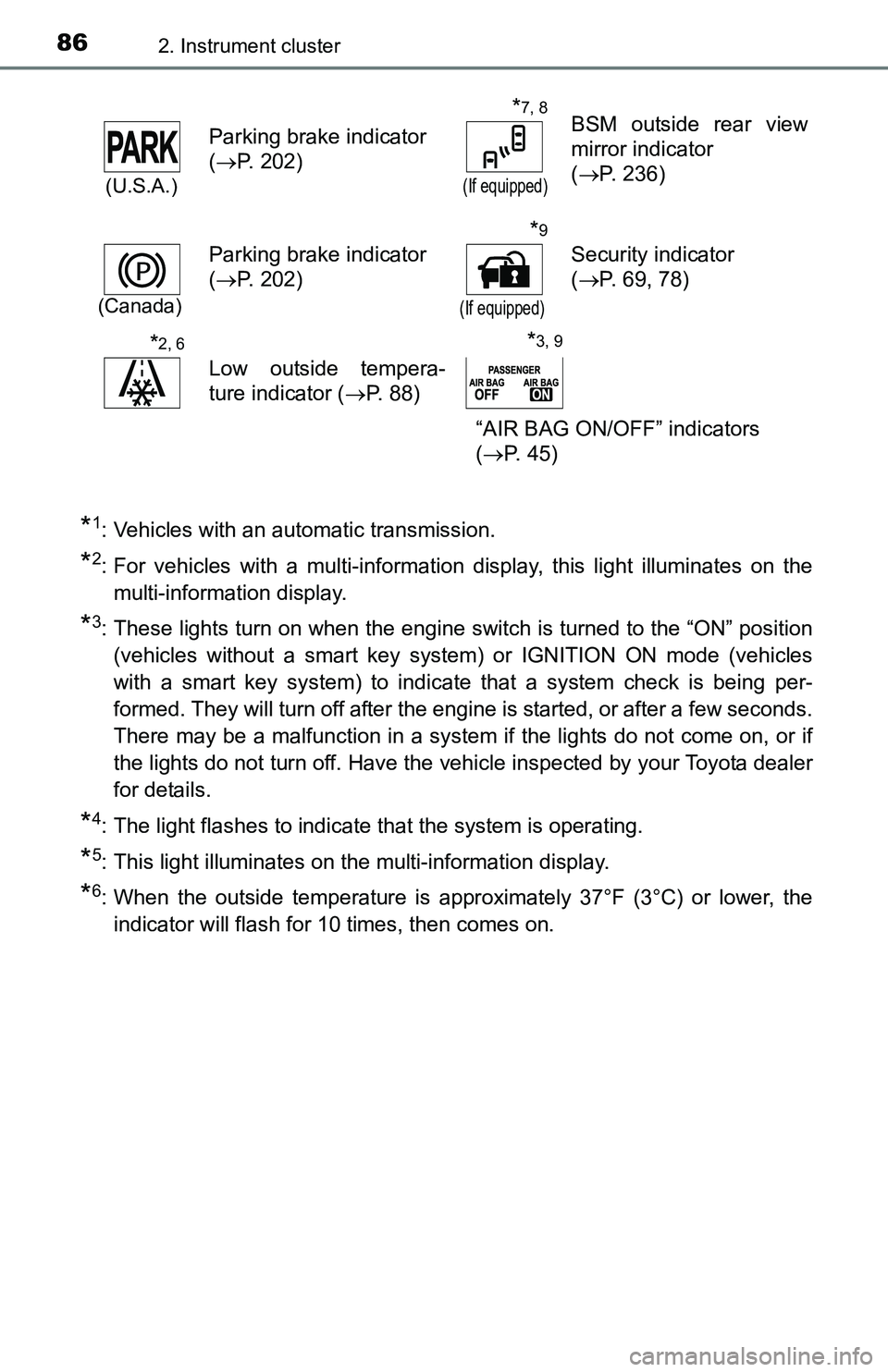
862. Instrument cluster
*1: Vehicles with an automatic transmission.
*2: For vehicles with a multi-information display, this light illuminates on the
multi-information display.
*3: These lights turn on when the engine switch is turned to the “ON” position
(vehicles without a smart key system) or IGNITION ON mode (vehicles
with a smart key system) to indicate that a system check is being per-
formed. They will turn off after the engine is started, or after a few seconds.
There may be a malfunction in a system if the lights do not come on, or if
the lights do not turn off. Have the vehicle inspected by your Toyota dealer
for details.
*4: The light flashes to indicate that the system is operating.
*5: This light illuminates on the multi-information display.
*6: When the outside temperature is approximately 37°F (3°C) or lower, the
indicator will flash for 10 times, then comes on.
(U.S.A.)
Parking brake indicator
(P. 202)
*7, 8
(If equipped)
BSM outside rear view
mirror indicator
(P. 236)
(Canada)
Parking brake indicator
(P. 202)
*9
(If equipped)
Security indicator
(P. 69, 78)
*2, 6
Low outside tempera-
ture indicator (P. 88)
“AIR BAG ON/OFF” indicators
(P. 45)
*3, 9
Page 153 of 640
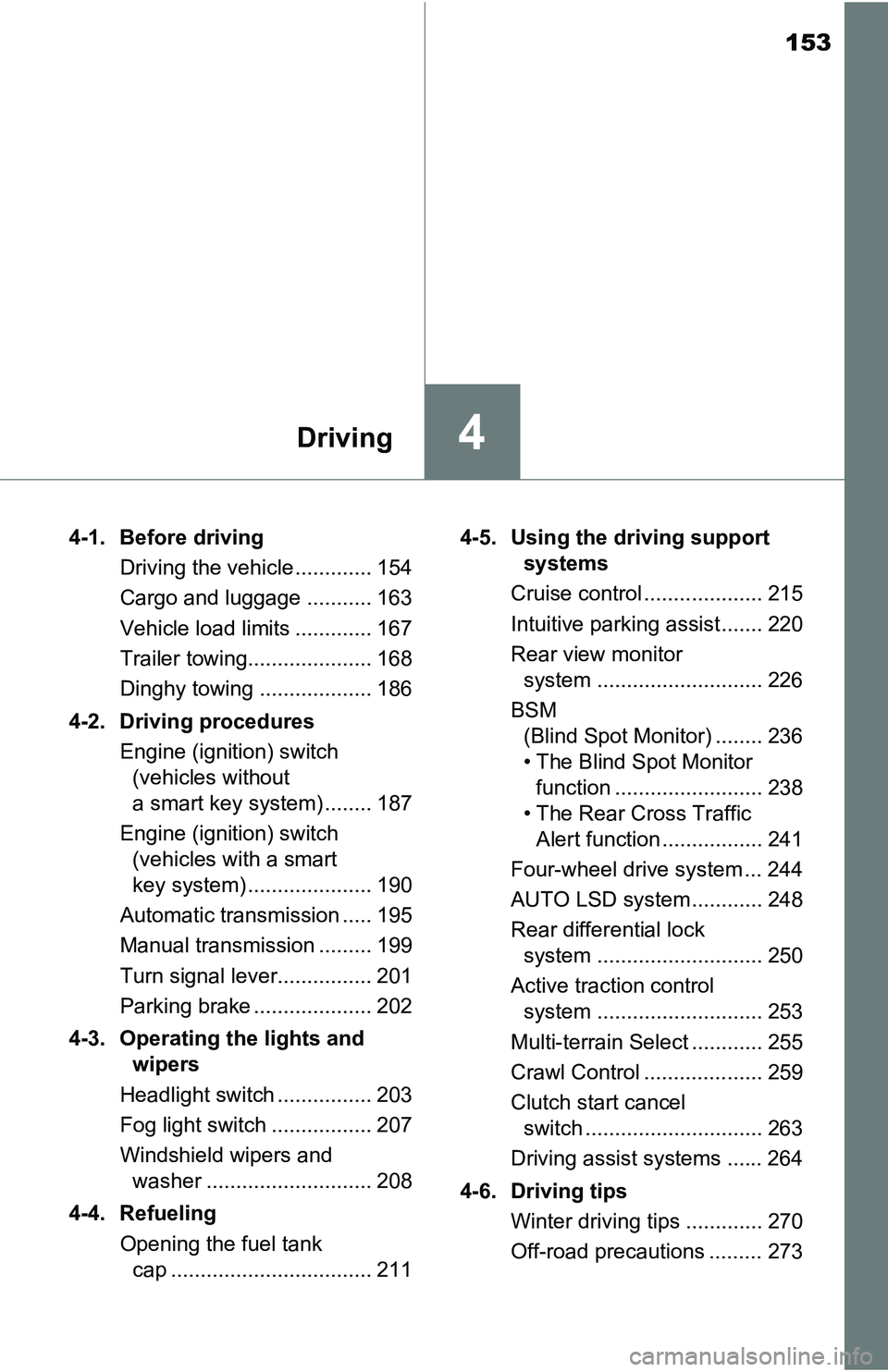
153
4Driving
4-1. Before driving
Driving the vehicle ............. 154
Cargo and luggage ........... 163
Vehicle load limits ............. 167
Trailer towing..................... 168
Dinghy towing ................... 186
4-2. Driving procedures
Engine (ignition) switch
(vehicles without
a smart key system) ........ 187
Engine (ignition) switch
(vehicles with a smart
key system) ..................... 190
Automatic transmission ..... 195
Manual transmission ......... 199
Turn signal lever................ 201
Parking brake .................... 202
4-3. Operating the lights and
wipers
Headlight switch ................ 203
Fog light switch ................. 207
Windshield wipers and
washer ............................ 208
4-4. Refueling
Opening the fuel tank
cap .................................. 2114-5. Using the driving support
systems
Cruise control .................... 215
Intuitive parking assist....... 220
Rear view monitor
system ............................ 226
BSM
(Blind Spot Monitor) ........ 236
• The Blind Spot Monitor
function ......................... 238
• The Rear Cross Traffic
Alert function ................. 241
Four-wheel drive system ... 244
AUTO LSD system............ 248
Rear differential lock
system ............................ 250
Active traction control
system ............................ 253
Multi-terrain Select ............ 255
Crawl Control .................... 259
Clutch start cancel
switch .............................. 263
Driving assist systems ...... 264
4-6. Driving tips
Winter driving tips ............. 270
Off-road precautions ......... 273
Page 155 of 640
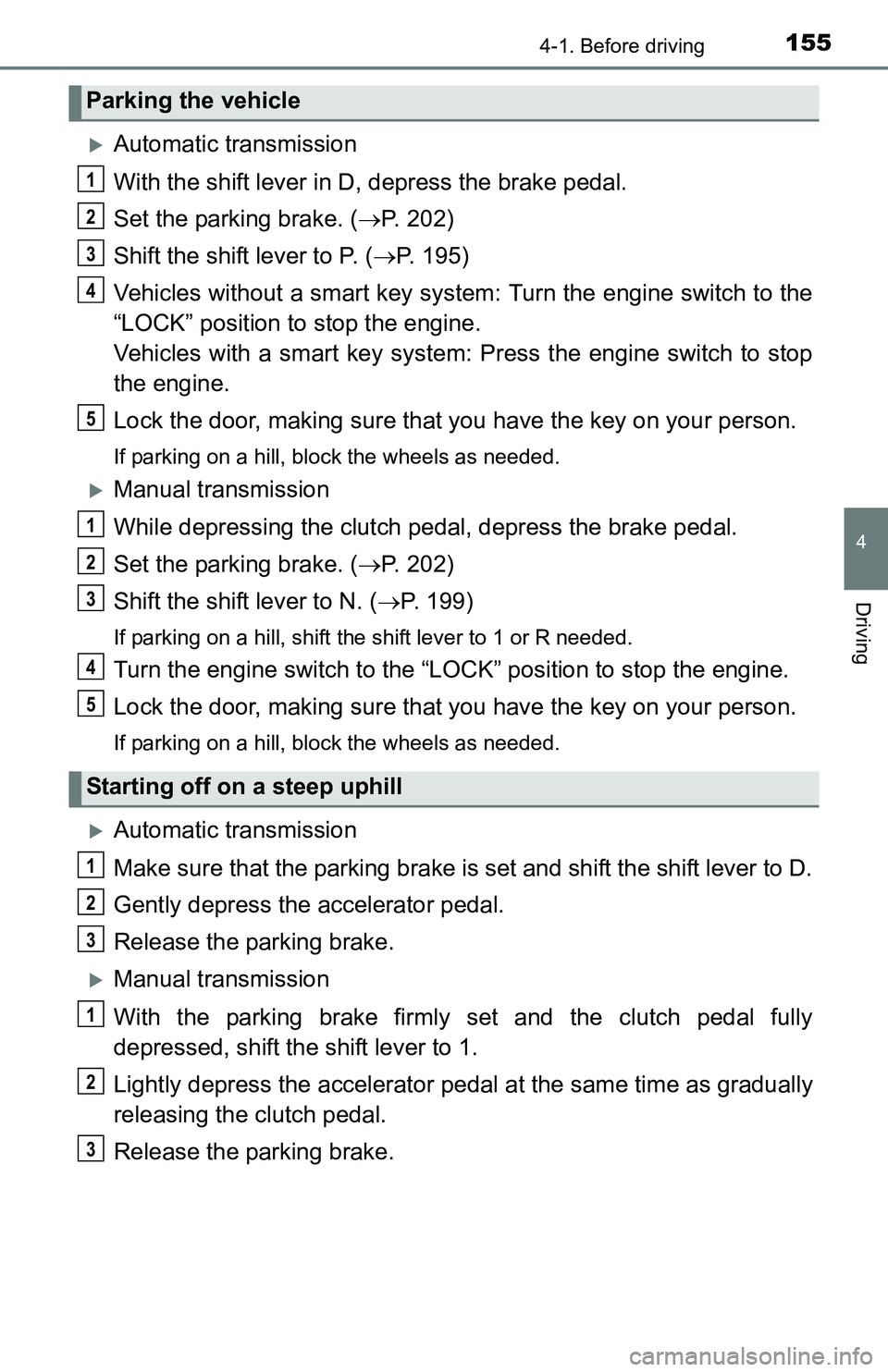
1554-1. Before driving
4
Driving
Automatic transmission
With the shift lever in D, depress the brake pedal.
Set the parking brake. (P. 202)
Shift the shift lever to P. (P. 195)
Vehicles without a smart key system: Turn the engine switch to the
“LOCK” position to stop the engine.
Vehicles with a smart key system: Press the engine switch to stop
the engine.
Lock the door, making sure that you have the key on your person.
If parking on a hill, block the wheels as needed.
Manual transmission
While depressing the clutch pedal, depress the brake pedal.
Set the parking brake. (P. 202)
Shift the shift lever to N. (P. 199)
If parking on a hill, shift the shift lever to 1 or R needed.
Turn the engine switch to the “LOCK” position to stop the engine.
Lock the door, making sure that you have the key on your person.
If parking on a hill, block the wheels as needed.
Automatic transmission
Make sure that the parking brake is set and shift the shift lever to D.
Gently depress the accelerator pedal.
Release the parking brake.
Manual transmission
With the parking brake firmly set and the clutch pedal fully
depressed, shift the shift lever to 1.
Lightly depress the accelerator pedal at the same time as gradually
releasing the clutch pedal.
Release the parking brake.
Parking the vehicle
Starting off on a steep uphill
1
2
3
4
5
1
2
3
4
5
1
2
3
1
2
3
Page 156 of 640
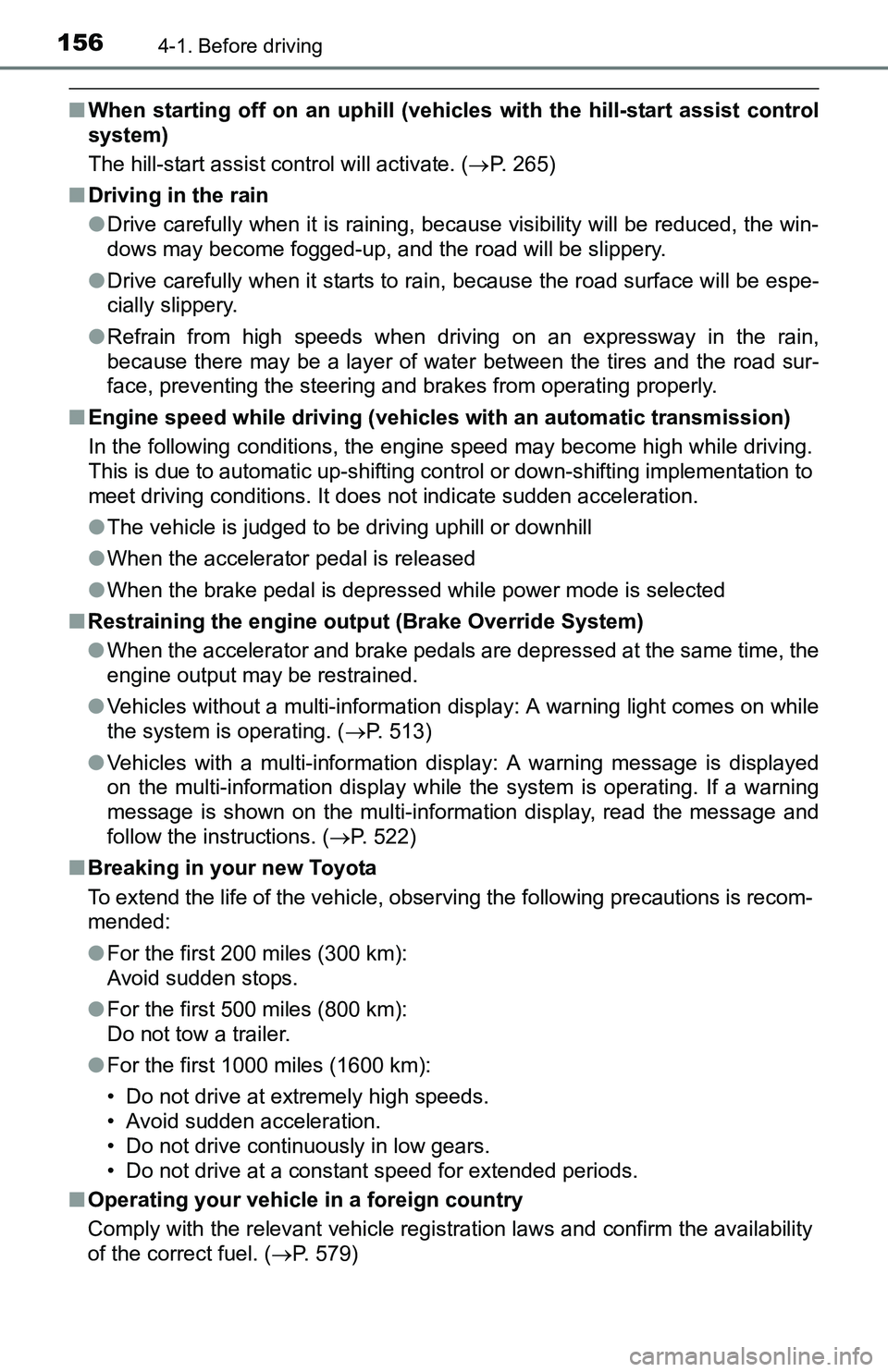
1564-1. Before driving
■When starting off on an uphill (vehicles with the hill-start assist control
system)
The hill-start assist control will activate. (P. 265)
■Driving in the rain
●Drive carefully when it is raining, because visibility will be reduced, the win-
dows may become fogged-up, and the road will be slippery.
●Drive carefully when it starts to rain, because the road surface will be espe-
cially slippery.
●Refrain from high speeds when driving on an expressway in the rain,
because there may be a layer of water between the tires and the road sur-
face, preventing the steering and brakes from operating properly.
■Engine speed while driving (vehicles with an automatic transmission)
In the following conditions, the engine speed may become high while driving.
This is due to automatic up-shifting control or down-shifting implementation to
meet driving conditions. It does not indicate sudden acceleration.
●The vehicle is judged to be driving uphill or downhill
●When the accelerator pedal is released
●When the brake pedal is depressed while power mode is selected
■Restraining the engine output (Brake Override System)
●When the accelerator and brake pedals are depressed at the same time, the
engine output may be restrained.
●Vehicles without a multi-information display: A warning light comes on while
the system is operating. (P. 513)
●Vehicles with a multi-information display: A warning message is displayed
on the multi-information display while the system is operating. If a warning
message is shown on the multi-information display, read the message and
follow the instructions. (P. 522)
■Breaking in your new Toyota
To extend the life of the vehicle, observing the following precautions is recom-
mended:
●For the first 200 miles (300 km):
Avoid sudden stops.
●For the first 500 miles (800 km):
Do not tow a trailer.
●For the first 1000 miles (1600 km):
• Do not drive at extremely high speeds.
• Avoid sudden acceleration.
• Do not drive continuously in low gears.
• Do not drive at a constant speed for extended periods.
■Operating your vehicle in a foreign country
Comply with the relevant vehicle registration laws and confirm the availability
of the correct fuel. (P. 579)
Page 157 of 640
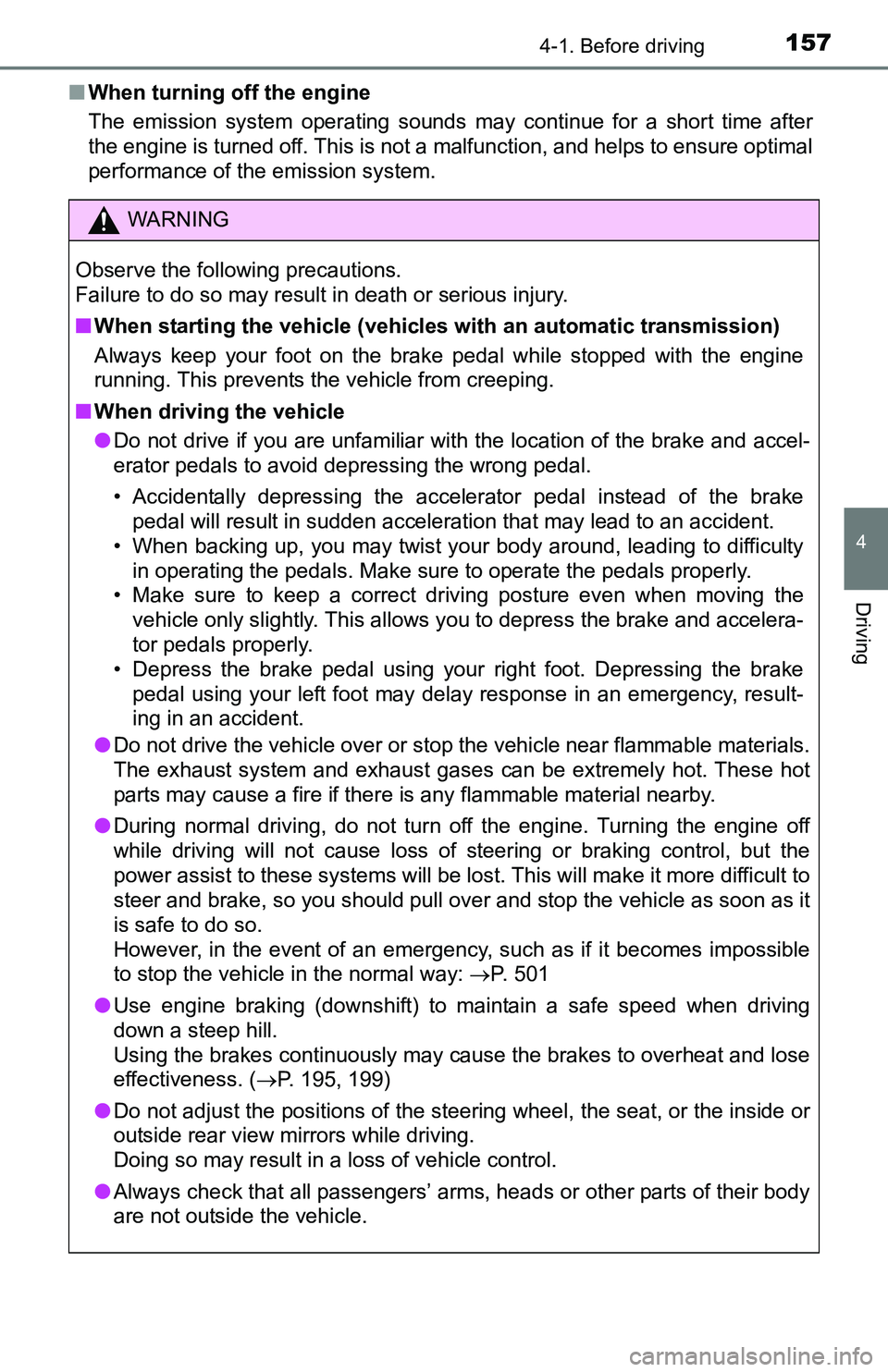
1574-1. Before driving
4
Driving
■When turning off the engine
The emission system operating sounds may continue for a short time after
the engine is turned off. This is not a malfunction, and helps to ensure optimal
performance of the emission system.
WARNING
Observe the following precautions.
Failure to do so may result in death or serious injury.
■When starting the vehicle (vehicles with an automatic transmission)
Always keep your foot on the brake pedal while stopped with the engine
running. This prevents the vehicle from creeping.
■When driving the vehicle
●Do not drive if you are unfamiliar with the location of the brake and accel-
erator pedals to avoid depressing the wrong pedal.
• Accidentally depressing the accelerator pedal instead of the brake
pedal will result in sudden acceleration that may lead to an accident.
• When backing up, you may twist your body around, leading to difficulty
in operating the pedals. Make sure to operate the pedals properly.
• Make sure to keep a correct driving posture even when moving the
vehicle only slightly. This allows you to depress the brake and accelera-
tor pedals properly.
• Depress the brake pedal using your right foot. Depressing the brake
pedal using your left foot may delay response in an emergency, result-
ing in an accident.
●Do not drive the vehicle over or stop the vehicle near flammable materials.
The exhaust system and exhaust gases can be extremely hot. These hot
parts may cause a fire if there is any flammable material nearby.
●During normal driving, do not turn off the engine. Turning the engine off
while driving will not cause loss of steering or braking control, but the
power assist to these systems will be lost. This will make it more difficult to
steer and brake, so you should pull over and stop the vehicle as soon as it
is safe to do so.
However, in the event of an emergency, such as if it becomes impossible
to stop the vehicle in the normal way: P. 501
●Use engine braking (downshift) to maintain a safe speed when driving
down a steep hill.
Using the brakes continuously may cause the brakes to overheat and lose
effectiveness. (P. 195, 199)
●Do not adjust the positions of the steering wheel, the seat, or the inside or
outside rear view mirrors while driving.
Doing so may result in a loss of vehicle control.
●Always check that all passengers’ arms, heads or other parts of their body
are not outside the vehicle.
Page 158 of 640
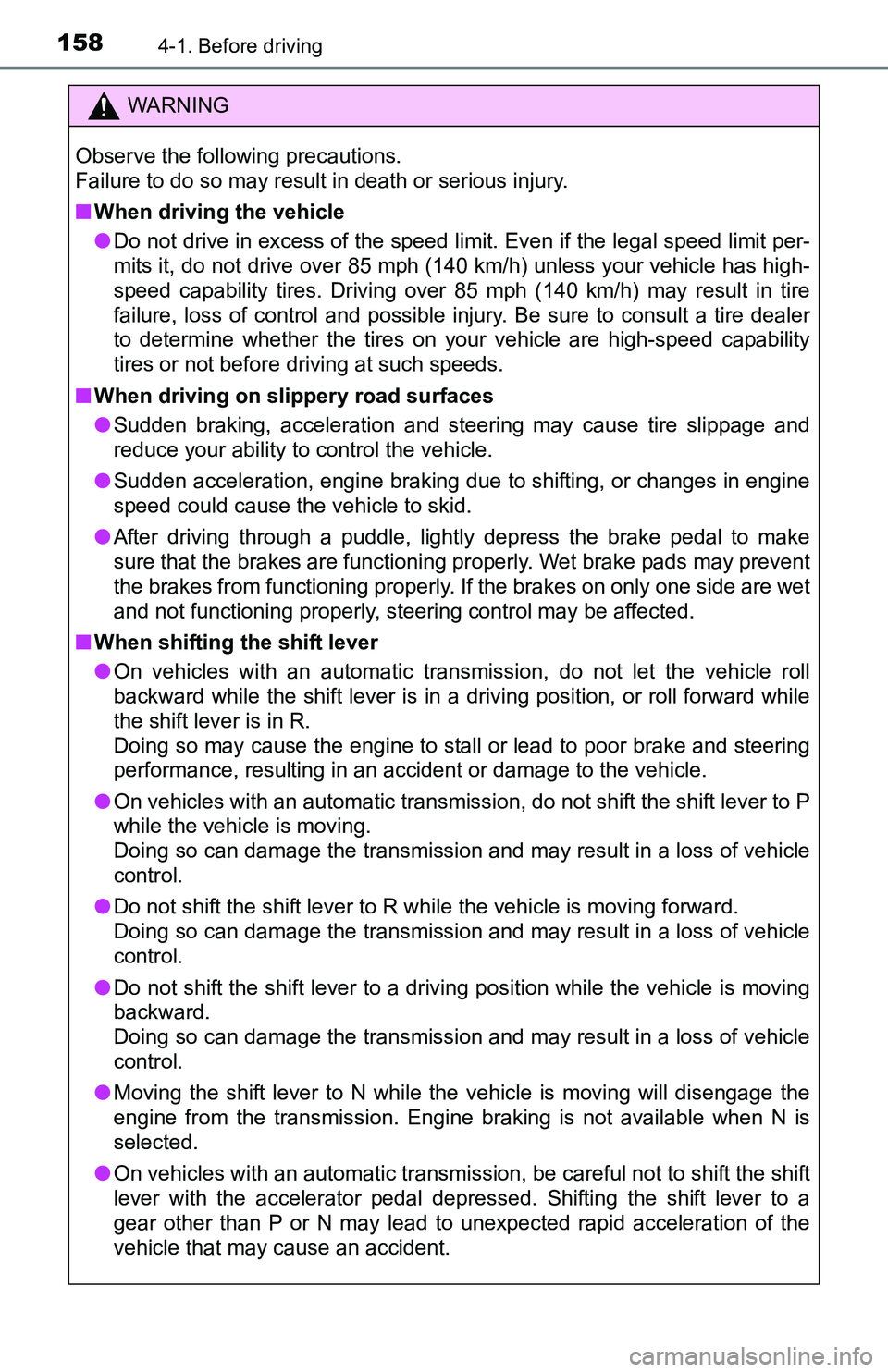
1584-1. Before driving
WARNING
Observe the following precautions.
Failure to do so may result in death or serious injury.
■When driving the vehicle
●Do not drive in excess of the speed limit. Even if the legal speed limit per-
mits it, do not drive over 85 mph (140 km/h) unless your vehicle has high-
speed capability tires. Driving over 85 mph (140 km/h) may result in tire
failure, loss of control and possible injury. Be sure to consult a tire dealer
to determine whether the tires on your vehicle are high-speed capability
tires or not before driving at such speeds.
■When driving on slippery road surfaces
●Sudden braking, acceleration and steering may cause tire slippage and
reduce your ability to control the vehicle.
●Sudden acceleration, engine braking due to shifting, or changes in engine
speed could cause the vehicle to skid.
●After driving through a puddle, lightly depress the brake pedal to make
sure that the brakes are functioning properly. Wet brake pads may prevent
the brakes from functioning properly. If the brakes on only one side are wet
and not functioning properly, steering control may be affected.
■When shifting the shift lever
●On vehicles with an automatic transmission, do not let the vehicle roll
backward while the shift lever is in a driving position, or roll forward while
the shift lever is in R.
Doing so may cause the engine to stall or lead to poor brake and steering
performance, resulting in an accident or damage to the vehicle.
●On vehicles with an automatic transmission, do not shift the shift lever to P
while the vehicle is moving.
Doing so can damage the transmission and may result in a loss of vehicle
control.
●Do not shift the shift lever to R while the vehicle is moving forward.
Doing so can damage the transmission and may result in a loss of vehicle
control.
●Do not shift the shift lever to a driving position while the vehicle is moving
backward.
Doing so can damage the transmission and may result in a loss of vehicle
control.
●Moving the shift lever to N while the vehicle is moving will disengage the
engine from the transmission. Engine braking is not available when N is
selected.
●On vehicles with an automatic transmission, be careful not to shift the shift
lever with the accelerator pedal depressed. Shifting the shift lever to a
gear other than P or N may lead to unexpected rapid acceleration of the
vehicle that may cause an accident.